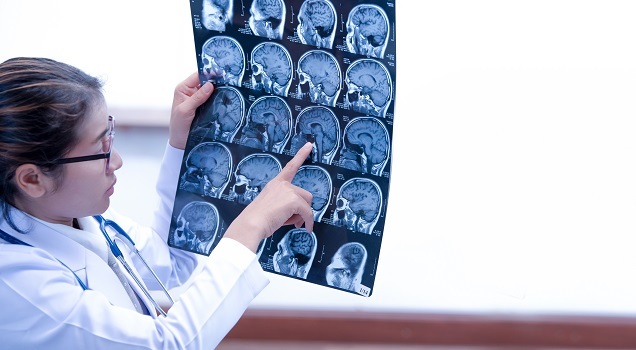
 Data Structure
Data Structure Networking
Networking RDBMS
RDBMS Operating System
Operating System Java
Java MS Excel
MS Excel iOS
iOS HTML
HTML CSS
CSS Android
Android Python
Python C Programming
C Programming C++
C++ C#
C# MongoDB
MongoDB MySQL
MySQL Javascript
Javascript PHP
PHP
- Selected Reading
- UPSC IAS Exams Notes
- Developer's Best Practices
- Questions and Answers
- Effective Resume Writing
- HR Interview Questions
- Computer Glossary
- Who is Who
What is the full form of CVA ?
Introduction
Cerebrovascular accident (CVA) is referred to as a stroke where free flow of blood to a portion of the brain shuts off, resulting in higher chances of death of the person depending on the severity of the medical issue.

The brain cells begin to degenerate within a few minutes because the blood is unable to provide them with the essential nutrients and oxygen they require. Death, serious impairments, or even permanent brain damage could happen.
Symptoms of stroke
Keep a close eye on the time the symptoms started if you suspect that you or someone you are with is experiencing a stroke. The effectiveness of some treatments depends on how quickly they are administered after a stroke starts.
Patients could suddenly feel numb, stiff, or paralyzed in the face, arms, or legs. Typically, just one side of the body is impacted. Attempt to raise both arms in synchronization above your head. If one of a person's arms starts to fall, he or she may be experiencing a stroke. One side of his mouth can also collapse as you try to smile.
One might experience communication and hearing difficulties, may sound puzzled, fumble over words, or find it difficult to follow conversations.
There is a chance that one or both eyes could abruptly turn fuzzy or dark, or that the person could experience double vision.
When a sudden, severe headache is accompanied by nausea, wooziness, or dizziness, it may be an indication that you are having a stroke.
You could fall or lose your balance. Fainting or a sudden loss of balance are two possible symptoms.
Types of Stroke
There are two basic types of cerebrovascular accidents or strokes: ischemic strokes are caused by blockages, while hemorrhagic strokes are caused by blood vessel rupture. With both types of strokes, a part of the brain is starved of blood and oxygen, which leads to the degeneration of cells in the brain.
Ischemic Stroke ? A blood clot blocking a blood vessel causes an ischemic stroke, the most common type of stroke, which deprives a section of the brain of blood and oxygen. There are two ways this could happen. One way is by an embolic stroke, which occurs when a blood clot leaves the body and settles in a blood vessel in the brain. On the other hand, a thrombotic stroke occurs when a blood clot forms in a brain blood vessel.
Hemorrhagic Stroke ? A hemorrhagic stroke is brought on when a blood vessel bursts, or hemorrhages, blocking the flow of blood to a region of the brain. A hemorrhage can occur in any blood vessel in the brain or in the membrane that covers the brain.
Causes of stroke
Inappropriate blood flow in the brain's blood arteries leads to a CVA. This may cause cerebral arteries, veins, or capillaries to hemorrhage or get obstructed.

There are numerous different CVA risk factors. Compared to other kinds of CVA, some risk factors are more likely to result in Cerebrovascular accidents.
Treatment of Stroke
To lessen the risk of brain injury, managing a CVA requires proper medical management and medication. The treatment of underlying risk factors and restoration are the main goals of long-term management.
Various interventions are needed depending on the cause of the CVA. According to what is required and suitable, immediate treatment may involve the following ?
Keeping blood pressure within a healthy range and treating high or low blood pressure
Preserving heart health
Clotting agents
Glucose control
After a CVA, rehabilitation can start as soon as a few days have passed. Physical treatment, occupational therapy, speech and language therapy, and swallow therapy may need to be continued for months or longer for persons who have experienced severe brain damage as a result of a CVA.
Rehabilitation sessions may be inpatient or outpatient depending on the patient's degree of independence and function following a CVA.
Conclusion
A disturbance of blood flow or brain bleeding is referred to as a cerebrovascular accident. It may injure brain tissue and have an impact on a brain artery or vein.
Such situations call for immediate medical intervention as they are medical emergencies. Therapy can lessen the harm a CVA causes. The direct consequences of a Cerebrovascular accident could include head pain, weakness, altered eyesight, and convulsions. Rehab and CVA recurrence prevention is part of long-term management.
FAQs
Q1. Is it possible to stop a cerebrovascular accident?
Ans. Stay away from drinking and smoking. Too much might signify different things to different people. It's crucial to keep in mind that frequency of use is just as significant as volume.
Q2. What are the complications related to CVA?
Ans. Certain muscles, such as those on one side of the face or one arm, may become uncontrollable, or the person may lose the ability to move the paralyzed portion of the body. The patient could experience paralysis on one side of the body or lose control of certain muscles
Q3. Why is a stroke referred to as a cerebral vascular accident?
Ans. The terminology stroke and cerebral vascular accident /CVA were created. Today, stroke is frequently referred to as a "brain attack" to emphasize that it results from a lack of blood flow to the brain, much like a heart attack results from a lack of blood flow to the heart.

